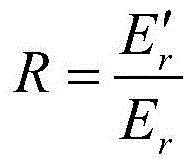Plant electric signal based crop salt tolerance evaluation method
An evaluation method and salt tolerance technology, applied in the field of agricultural biology, can solve the problems of unsuitable evaluation of rare varieties, failure of early diagnosis, destructive measurement, etc., and achieve reliable evaluation effect, less seed consumption, and rapid evaluation
- Summary
- Abstract
- Description
- Claims
- Application Information
AI Technical Summary
Problems solved by technology
Method used
Image
Examples
Embodiment 1
[0074] The maize variety Wanrui 168 with strong salt tolerance and Zhengdan 958 with weak salt tolerance were selected.
[0075] The plump seeds with consistent appearance were washed with distilled water, and the mass fraction was added with 0.2% HgCl 2 Disinfect and clean. Put the filter paper into the bottom of the petri dish, and put 10 seeds of the two varieties into the petri dish evenly. After adding an appropriate amount of distilled water to the culture dish, put it into an incubator for cultivation. After the seeds germinated, they were transplanted into hydroponic dishes for growth. Pour appropriate amount of distilled water every day to ensure its normal growth needs. When the crops germinate 3 to 4 leaves, the plant height is 10cm to 20cm.
[0076] A single crop seedling was placed in a Faraday cage, and test electrodes were placed on the leaves and roots respectively, and the surface potential signal of the leaves was collected with a biofunctional experiment...
Embodiment 2
[0080] The maize variety Wanrui 168 with strong salt tolerance and Zhengdan 958 with weak salt tolerance were selected.
[0081] The plump seeds with consistent appearance were washed with distilled water, and the mass fraction was added with 0.2% HgCl 2 Disinfect and clean. Put the filter paper into the bottom of the petri dish, and put 10 seeds of the two varieties into the petri dish evenly. After adding an appropriate amount of distilled water to the culture dish, put it into an incubator for cultivation. After the seeds germinated, they were transplanted into hydroponic dishes for growth. Pour appropriate amount of distilled water every day to ensure its normal growth needs. When the crops germinate 3 to 4 leaves, the plant height is 10cm to 20cm.
[0082] A single crop seedling was placed in a Faraday cage, and test electrodes were placed on the leaves and roots respectively, and the surface potential signal of the leaves was collected with a biofunctional experiment...
PUM
 Login to View More
Login to View More Abstract
Description
Claims
Application Information
 Login to View More
Login to View More - R&D
- Intellectual Property
- Life Sciences
- Materials
- Tech Scout
- Unparalleled Data Quality
- Higher Quality Content
- 60% Fewer Hallucinations
Browse by: Latest US Patents, China's latest patents, Technical Efficacy Thesaurus, Application Domain, Technology Topic, Popular Technical Reports.
© 2025 PatSnap. All rights reserved.Legal|Privacy policy|Modern Slavery Act Transparency Statement|Sitemap|About US| Contact US: help@patsnap.com



